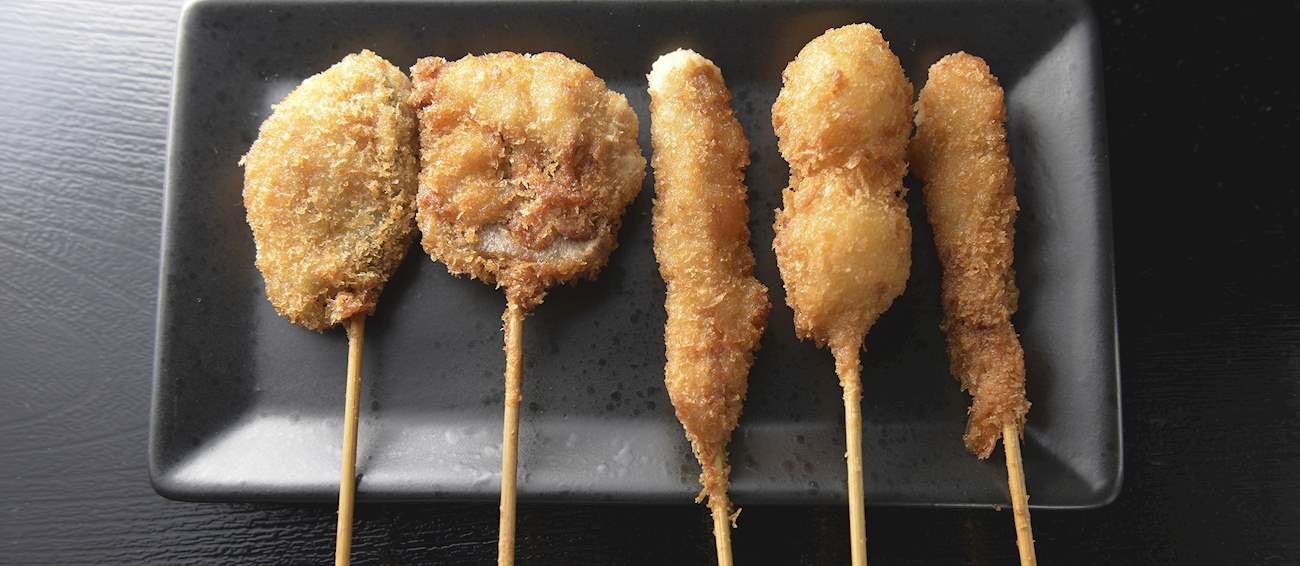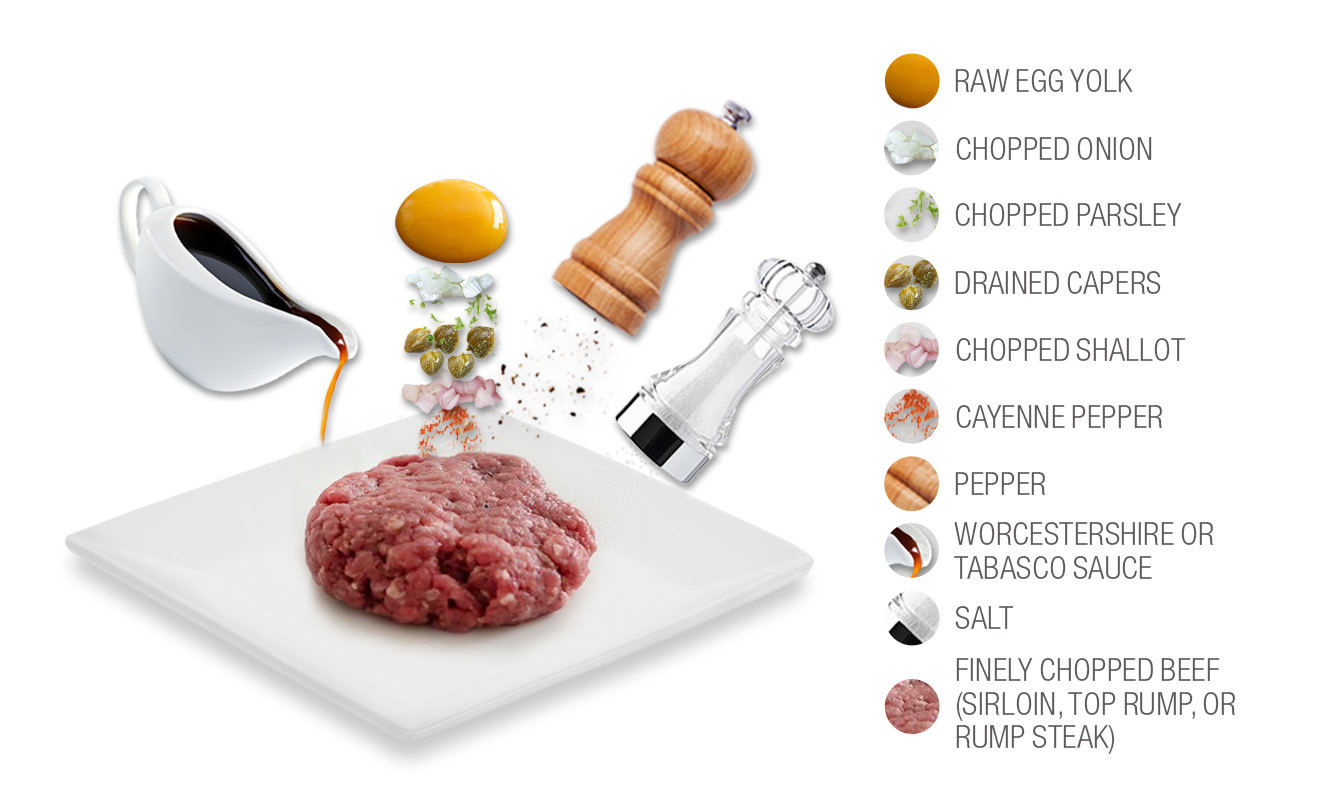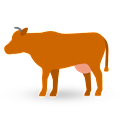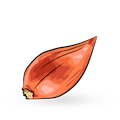Steak tartare is an appetizer made with finely chopped raw beef or horse meat that is seasoned with salt, pepper, Worcestershire sauce, Tabasco, and mustard. The meat is combined with a raw egg yolk, capers, shallots, parsley, and (sometimes) chopped gherkins.
When served, steak tartare is usually accompanied by toasted bread, rye bread, or french fries. It is believed that steak tartare was originally a variation on beefsteack à l'Américaine, a dish of raw chopped beefsteak that first appeared in France at the turn of the 20th century.
MOST ICONIC Steak tartare
View moreBreaded, skewered with a bamboo stick and deep-fried, the delectable bite-sized pieces of various fish and seafood, pork, chicken, beef, and even horse meat or fresh vegetables are collectively called kushiage, also kushikatsu, and originate from Osaka, a city aptly nicknamed the kitchen of Japan.
Kushiage first appeared in the 1920s in Shinsekai, but today, these incredibly popular fried skewers can be enjoyed anywhere from numerous street food stands to kushiage-specialized restaurants that offer a truly unique Japanese dining experience.
And while the street snack version of kushiage is simply served with a Worcestershire-like brown sauce which comes in a communal pot, the gourmet kushiage prepared at high-end Asian fusion restaurants is amazingly creative and sophisticated.
MOST ICONIC Kushiage
View moreMAIN INGREDIENTS
Lókolbász is a Hungarian sausage made from horse meat. During the preparation process, the meat is flavored with paprika, garlic, and caraway. Occasionally, pork fat is added to enrich the flavor and improve texture. Horse sausage is typically cooked and served on a plate with various vegetables, but it can also be used as an ingredient in stews and traditional goulashes.
MAIN INGREDIENTS
Bocadillo de carne de caballo is a traditional sandwich that’s filled with horse meat. Typically, a Spanish-style baguette called barra de pan is sliced in half lengthwise, and it is then stuffed with pieces of roasted, fried, or grilled horse meat.
Other common ingredients added to the sandwich’s filling include young garlic, slices of cheese, crispy-fried bacon, beans, and onions. This variety of the Spanish bocadillo sandwich is typically served with accompaniments such as a glass of cold beer or red wine, a cup of coffee, olives, and peanuts on the side.
MAIN INGREDIENTS
Qazı is a traditional sausage made from horsemeat, commonly found in Central Asian countries such as Kazakhstan, Kyrgyzstan, Uzbekistan, and among Tatar people. It is considered a delicacy in these regions, where horsemeat has long been an integral part of the diet.
The sausage is typically prepared using the rib meat and fat of horses, which is stuffed into natural casings (usually horse intestines). The meat is seasoned with salt and sometimes light spices, and it can be either boiled or dried. Qazı has a rich, fatty flavor and a firm, chewy texture, making it quite robust in taste.
MAIN INGREDIENTS
Panino con straccetti di cavallo is a traditional sandwich featuring thin strips of horse meat, popular in regions like Apulia and Sicily, where horse meat is part of the local culinary heritage. The straccetti di cavallo are tender slices of meat, often marinated with olive oil, garlic, and rosemary, then quickly cooked over high heat to retain their flavor and juiciness.
Served on a rustic Italian roll or ciabatta, the sandwich is typically accompanied by sautéed onions, fresh arugula, grilled vegetables, or a drizzle of olive oil. Some variations include spicy sauces or mustard for added zest. The result is a rich, savory sandwich, with the slightly sweet and gamey flavor of horse meat complemented by the fresh, aromatic ingredients.
MAIN INGREDIENTS
Carne di cavallo alla brace is a traditional Sicilian dish made with grilled horse meat. The phrase "alla brace" translates to "on the coals," indicating that the meat is cooked over an open flame or hot charcoal, which imparts a smoky and rich flavor to the dish.
Horse meat used for this dish is typically very lean, tender, and flavorful. It is often prepared as steaks, cutlets, or skewers. The meat is usually seasoned simply with salt, pepper, and sometimes olive oil to enhance its natural flavor without overpowering it.
TasteAtlas food rankings are based on the ratings of the TasteAtlas audience, with a series of mechanisms that recognize real users and that ignore bot, nationalist or local patriotic ratings, and give additional value to the ratings of users that the system recognizes as knowledgeable. For the “7 Best Rated Dishes With Horse Meat” list until February 16, 2025, 789,953 ratings were recorded, of which 515,851 were recognized by the system as legitimate. TasteAtlas Rankings should not be seen as the final global conclusion about food. Their purpose is to promote excellent local foods, instill pride in traditional dishes, and arouse curiosity about dishes you haven’t tried.















